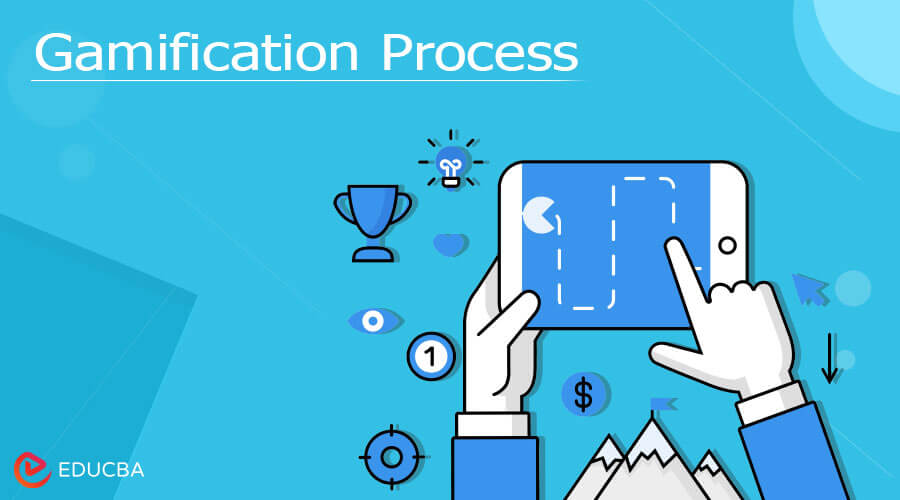Updated May 5, 2023

What is Gamification Process?
Defining the gamification process can be as simple as a technique to apply the different elements involved in gameplay, such as points, levels, and rules to other areas of activity, specifically within business setups. This modification to the business model is to encourage thorough employee engagement in the work they perform as they would within a game.
The entire concept of the gamification process sounds marvelous and can be the greatest thing ever. Imagine having to play your way through a regular workday in order to receive points, rewards, and gold coins at the end.
With employee engagement comes the fact that work rendered is more concentrated and of high quality as each aspect of the work comes under the gamification process’s radar. Game mechanics and techniques can be instrumental in bringing out an employee’s creative side and zeal for completing the job with utter motivation and dedication.
Ever since its induction into the world of businesses, the gamification process has rightly earned a place for itself. It has been quite a driving force toward achieving targets, company goals, and individual objectives.
Merging Gamification process with Project Management
Now with the gamification process ever so prominent on the business scene, project managers are taking this unique technique of using game mechanics and putting it right where it will gain a lot of traction—Projects!
The idea of merging the gamification process with project management seems perfect. The premise is to use the gameplay model and carefully design rewarding systems and points for employees around their daily productivity and contribution toward project goals. You can award team members a higher level each time they contribute to the business in a way they are supposed to. With this level of competitiveness, the rewards will soon make your work feel like an enjoyable game.
The gamification process and project management principles fit like a hand in a glove. In project management, you have a goal to be achieved, and your employees are the only means of reaching that goal. You also need to keep your employees satisfied with the work environment you set for them, thus, making them want a bigger chunk of the work rendered each time. This accounts for a win-win situation for both the organization and the employees, with high productivity levels, quality, and creative passion for the work done.
Do You Really Need a Gamification Process to Keep Your Project Team Engaged?
Employee disengagement is one of the most critical problems to hit organizations, with many employees pleading that they are not satisfied with the projects they are allotted and no proper scope for continuing work here. According to Gallup stats, at the time of writing this article, a staggering 66% of employees are found to be disengaged at their workplace and look out for motivation to stay and perform with fervor and zeal.
With this stark increase in employee disengagement catching up with the inferior services to products, the organization is looking out towards other exciting and inviting platforms for their employees to gain the necessary motivation and active engagement. This is where the gamification process enters the scene. With corporate giants such as Salesforce and Accenture resorting to the concept of the gamification process, the traction it is receiving is huge, and its results are simply magnificent.
Gamification Process in Action
While you’re on a quest to find out about this technique of making work look less like work, and more like fun, you’re in line to watch gamification processing action. People have been doing this for many years now, but they aren’t aware that the gamification process is playing with them. Gaining a few prizes while at your job isn’t a bad deal. These deals are making project managers’ heads turn and luring them into the world of the gamification process.
People enjoy and love recognition and appreciation of their actions. It’s human nature to be in the game to win it and pursue to be victorious. Belonging to a team and heading towards winning can be the best dream for an employee, and more recognition for a great job would mean boosted morale and efficient work per set parameters for a job.
The Gamification System taps into this repository of human feelings towards wins and gaining recognition, bringing out the champion in us. The idea of having a weekly leadership board with your name reaching the top or a token of appreciation for hard work and applause in front of your colleagues for making the impossible seem simple can very much be the various techniques involved in the gamification system. Win the award 3 times in a row, and you get a bigger bonanza award for making the cut thrice and contributing ever so handsomely to the organization. These social triggers are instrumental in gaining employees’ attention and making work enjoyable.
Over the years, studies have shown that this act has really interesting results in the organization’s output and quality. Not only is your work done, but the proven benefits include:
- Increased productivity; as work has now become fun so people are at it for a longer duration of time
- Increased employee satisfaction; your workplace is now an exciting place to be at, and you wouldn’t want to let it go
- Increased employee retention; if an organization is giving you everything you need and ask for, there’s no reason to leave
- Increased quality; overall process quality is increased, and the company is belting out more qualitative products
- Increased employee morale; recognition can be very rewarding to the soul and can elevate employee moods
Gamification System for Collecting Data
The Gamification system employed by an organization is always for a reason. Building on game-like models to boost productivity can be easily put to use by organizations to collect data and information that can be extremely beneficial to them. Merging your gamification system model with a project management tool will encourage employees to use the tool in the best mode possible. It will also help you create and generate reports and tasks for the project. Thus, it ensures a smooth project workflow.
Software implementations can be boosted similarly, and user testing can be prodded by offering game-mechanized rewards for your employees. Take, for example, organizations such as Facebook and ad companies. They would come together and plot a game on Facebook to play with people worldwide. Meanwhile, they also capture necessary data and information from you with consent and hand over those pieces of data and information to ad companies, thus, helping them customize the ad contents on open websites you visit after that.
The Gamification System makes complete sense from a business perspective. It is here to stay for the coming years in organizations rearing to make profits and obtain valuable data and information. With more such data, decision-making will improve immensely.
Gamification System Strategies
Based on game mechanics, a gamification system needs a string of well-thought strategies that can be released for anyone under the target audience to play. Playing a game would mean collecting reward points and collaborating with your team members, colleagues, or people around you. It also involves taking up challenges and constantly wanting to move ahead in endeavors to reach the top on all the leadership boards present in the office or collect all the possible levels and badges, which can surely lead to a promotion someday.
Apart from these rewarding and recognition factors, these games must motivate and inspire employees facing these challenges. Positive inspiration always leads to growth and learning and can push an employee to achieve their potential in a very short span of time.
A game shouldn’t go wrong. A poorly constructed game can be detrimental to your plans for improving employee engagement. You must have a game designer to create the basic framework for your game so that nothing goes unnoticed, or you will have major consequences and conflicts at hand. Improper rules can also create a lot of ruckus for you and bring down your entire endeavor of uniting the team. Following their performances and how well they chart out on the leaderboard, as a leader, you will get the opportunity to give proper feedback to your employees who aren’t faring well with the games at hand.
Things to Keep in Mind about the Gamification System
The Gamification system is revolutionary on the business front, and project management is benefiting immensely from it. While you devise the best gameplay for your department or organization, it’s important that you also keep caution as a little deviation from your best interest and that of the employees. The Gamification system is a boon; there’s no question about it, but it all comes down to how you, as a business executive or project manager, handle the boon sincerely.
Enlisted below are 5 essential things you need to keep in mind when you intend to deploy gamification features:
- We love challenges, and it’s all part of the fun for gamification features. But, amidst this, there can also be a part of us that wants to level up the game so as to make it difficult and sometimes impossible to win. Make sure your games aren’t such hard nuts to crack.
- Create games that have opportunities for everyone to have a fair chance of winning. There shouldn’t be a single winner all the time. This can demoralize your employees and can dissuade them from trying to give in their best.
- Be the motivator and team person when encouraging your team towards the games. Teamwork against individual efforts is easier to commend and measure. Boosting your team in such gamified processes would be instrumental in showing off your caliber as a leader and uniting the team toward engagement.
- Avoid repetition in the challenges you present to the team and employees. There’s always discontent when there are high levels of repetition in the activities you offer.
- You should know exactly when to put gamification features to use. It won’t work for each department or workforce group and must be properly researched before implementation. It’s up to you to decide whether to keep the game or not. And, if it doesn’t suit your team or target audience, don’t hesitate to bring it down.
Conclusion
The comfort always attracts attention and keeps you up and motivated. Gamification features within businesses provide corporates with the opportunity to allow humans to be humans. Gamification features allow managers and leaders to gain their employees’ complete trust and help them get their team members to increase their productivity manifold. With that, the business has a win-win situation regarding achieving its set target and goals and the employees’ satisfaction levels.
Gamification features are slowly gaining momentum, and many organizations are adopting this manner of business administration to boost their overall business output successfully. When are you getting on the bandwagon?
Recommended Articles
This has been a guide to a gamification process that can be as simple as a technique to apply the different elements involved in gameplay, such as points, levels, and rules. These are the following external link related to the gamification process.



